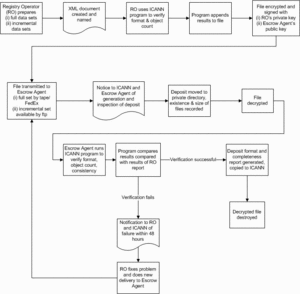Data Escrow: Difference between revisions
No edit summary |
No edit summary |
||
| Line 10: | Line 10: | ||
In November 2000, ICANN selected seven new gTLDs as part of a proof-of-concept round to expand the Internet name space. Registry Agreements for all 7 of these TLDs contained language based on the draft for the 2001 .com agreement with Verisign. These agreements were entered into between 2001 and 2002, beginning with [[.biz]] and [[.info]] in May 2001. | In November 2000, ICANN selected seven new gTLDs as part of a proof-of-concept round to expand the Internet name space. Registry Agreements for all 7 of these TLDs contained language based on the draft for the 2001 .com agreement with Verisign. These agreements were entered into between 2001 and 2002, beginning with [[.biz]] and [[.info]] in May 2001. | ||
Several of the original [[ccTLD]] Sponsorship Agreements and [[ | Several of the original [[ccTLD]] Sponsorship Agreements and [[MoU]]s also contained provisions for registry escrow. In 2004, however, ICANN moved away from the Sponsorship Agreement and MOU formats, opting for a lightweight Accountability Format, which does not contain detailed provisions for registry escrow, though it does encourage ccTLD managers to operate in a manner complaint to current [[IETF]] standards.<ref>[http://archive.icann.org/en/tlds/data-escrow-report05mar07.htm#Historical ICANN's gTLD Registry Data Escrow Requirements, icann.org]</ref> | ||
==Registry Data Escrow Agreement== | ==Registry Data Escrow Agreement== | ||
Revision as of 20:58, 28 July 2012
Data Escrow is the act of storing data with a neutral third party[1] in case of registry or registrar failure, accreditation termination, or accreditation relapse without renewal. ICANN requires all registrars and gTLD registries to contract with a data escrow provider in order to safeguard registrants.[2][3]
Registry Data Escrow[edit | edit source]

Registry data escrow is one of the essential stakeholder protection mechanisms for gTLDs. Registry Data Escrow ensures that the data associated with registered domain names is never at risk of being lost or inaccessible. Registry Data Escrow is a specialized data protection service designed to meet the compliance and “best practice” needs of domain name registrants worldwide. The service ensures that up-to-date copies of domain name ownership and contact details are held in escrow by a trusted, neutral third party (such as Iron Mountain), to be accessed and released only under pre-defined and controlled conditions. The purpose of Registry Data Escrow is to help safeguard registrar and registrant interests in the event of a registry’s business or technical failure.[4]
History[edit | edit source]
The original Registry Agreement, which lasted from 1999-2001, between ICANN and Network Solutions (and later Verisign) contained provisions for registry data escrow for the .com, .net, and .org gTLDs. In May 2001, ICANN entered into a new Registry Agreement with Verisign for .com, which included expanded escrow provisions. At that time they also entered into separate agreements for .org and .net.
In November 2000, ICANN selected seven new gTLDs as part of a proof-of-concept round to expand the Internet name space. Registry Agreements for all 7 of these TLDs contained language based on the draft for the 2001 .com agreement with Verisign. These agreements were entered into between 2001 and 2002, beginning with .biz and .info in May 2001.
Several of the original ccTLD Sponsorship Agreements and MoUs also contained provisions for registry escrow. In 2004, however, ICANN moved away from the Sponsorship Agreement and MOU formats, opting for a lightweight Accountability Format, which does not contain detailed provisions for registry escrow, though it does encourage ccTLD managers to operate in a manner complaint to current IETF standards.[5]
Registry Data Escrow Agreement[edit | edit source]
Registrar Data Escrow[edit | edit source]
The Registrar Data Escrow program was initiated by ICANN to protect data associated with registered domain names in a secure escrow environment.
History[edit | edit source]
The Registrar Accreditation Agreement requires ICANN-accredited registrars to periodically submit a copy of their registration database to ICANN, or a mutually-approved third-party escrow agent. In 2007, however, it came to light that ICANN had not followed through in ensuring that all of its registrars were doing so. After the failure of RegisterFly, the first registrar to go under, thousands of the company's customers lost their domain names or were forced to wait for months until their domains were eventually transferred to GoDaddy. Following this, ICANN made it a priority to review the RAA and more forcefully implement the Registrar Data Escrow program. Iron Mountain was selected to implement and execute Registrar Data Escrow.[6][7] All registrars at that time were expected to enroll in the RDE program within six months.[8]
- ↑ Guard-It.com FAQs
- ↑ Implementation of Registrar Data Escrow Program, icann.org
- ↑ ICANN's gTLD Registry Data Escrow Requirements, icann.org
- ↑ Registry Data Escrow Service, ironmountain.com
- ↑ ICANN's gTLD Registry Data Escrow Requirements, icann.org
- ↑ Iron Mountain lands ICANN data escrow agreement, theregister.co.uk
- ↑ Go Daddy rescues Registerfly customers, bobparsons.me
- ↑ Implementation of Registrar Data Escrow Program, icann.org
